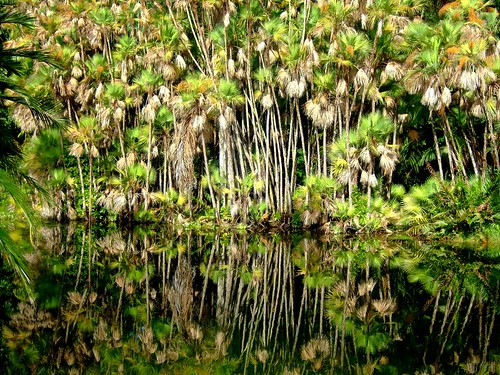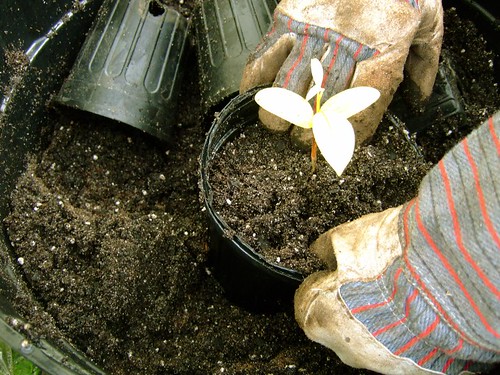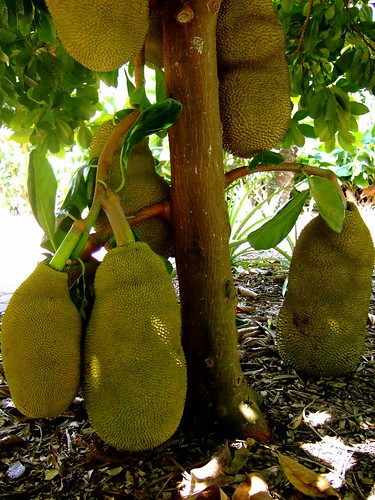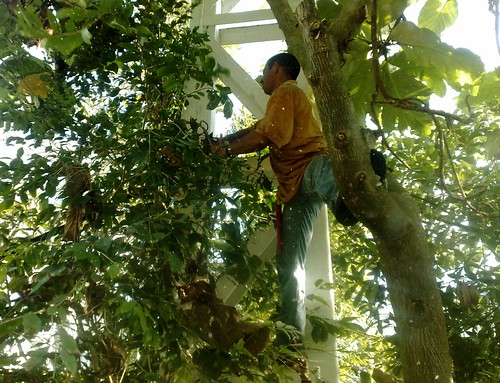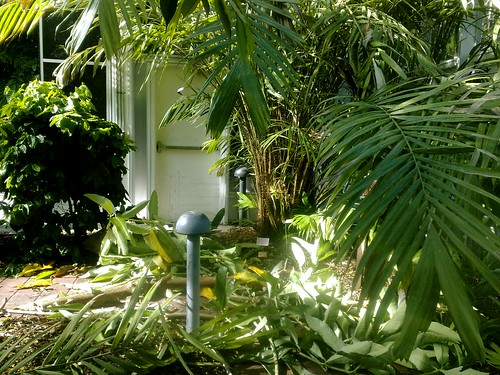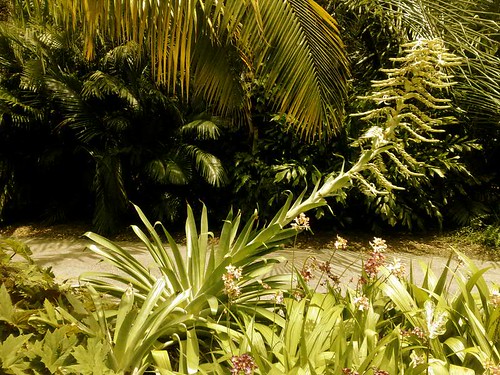One of the advantages of volunteering at Fairchild: morning light at 8:30 am, before doors open to the public. This grove is located by the Glade Lake, just east of the rainforest.
August 28, 2008
August 25, 2008
Volunteering - August 15
This week we had a change of pace from working at the fruit pavilion. We met at the Fairchild grounds at 8:30 am and then drove to the Center for Tropical Plant Conservation (CTPC) to work with plants in the nursery. Located just minutes from the Fairchild grounds, CTPC is where much of the scientific work takes place:
The Center for Tropical Plant Conservation is dedicated to conserving tropical plants, driven by the imperative to avoid the extinction of species and their habitats. These activities are measured by the delivery of quantifiable conservation benefits to Fairchild's priority geographic investment regions (South Florida, Caribbean, oceanic islands, tropical Africa, and Madagascar) and plant groups (palms, cycads, tropical fruit and tropical trees). These have been selected because of conservation need, institutional expertise and history. Main activities include field exploration of important plant areas, conservation assessments, species recovery and direct support to in-situ conservation.CTPC is unique not only for its mission, but also because it's one of few botanic gardens with a molecular lab, operated in association with Florida International University. As well, CTPC has an extensive herbarium of Florida and Caribbean botany, with over 165,000 specimens, some of which have been posted online in this incredible Virtual Herbarium.
On Friday, we worked inside one of the greenhouses.
 This particular nursery serves the tropical fruit program. The floor was rather slippery!
This particular nursery serves the tropical fruit program. The floor was rather slippery!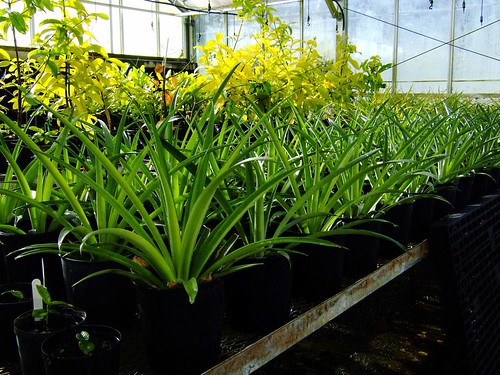 Jon-Mario planted each of these healthy young plants back in March from pineapple tops.
Jon-Mario planted each of these healthy young plants back in March from pineapple tops.Our task included repotting small sapodilla fruit trees to larger containers. Sapodilla is native to the Yucatan and was probably introduced to Florida from the Bahamas in the 1800s.
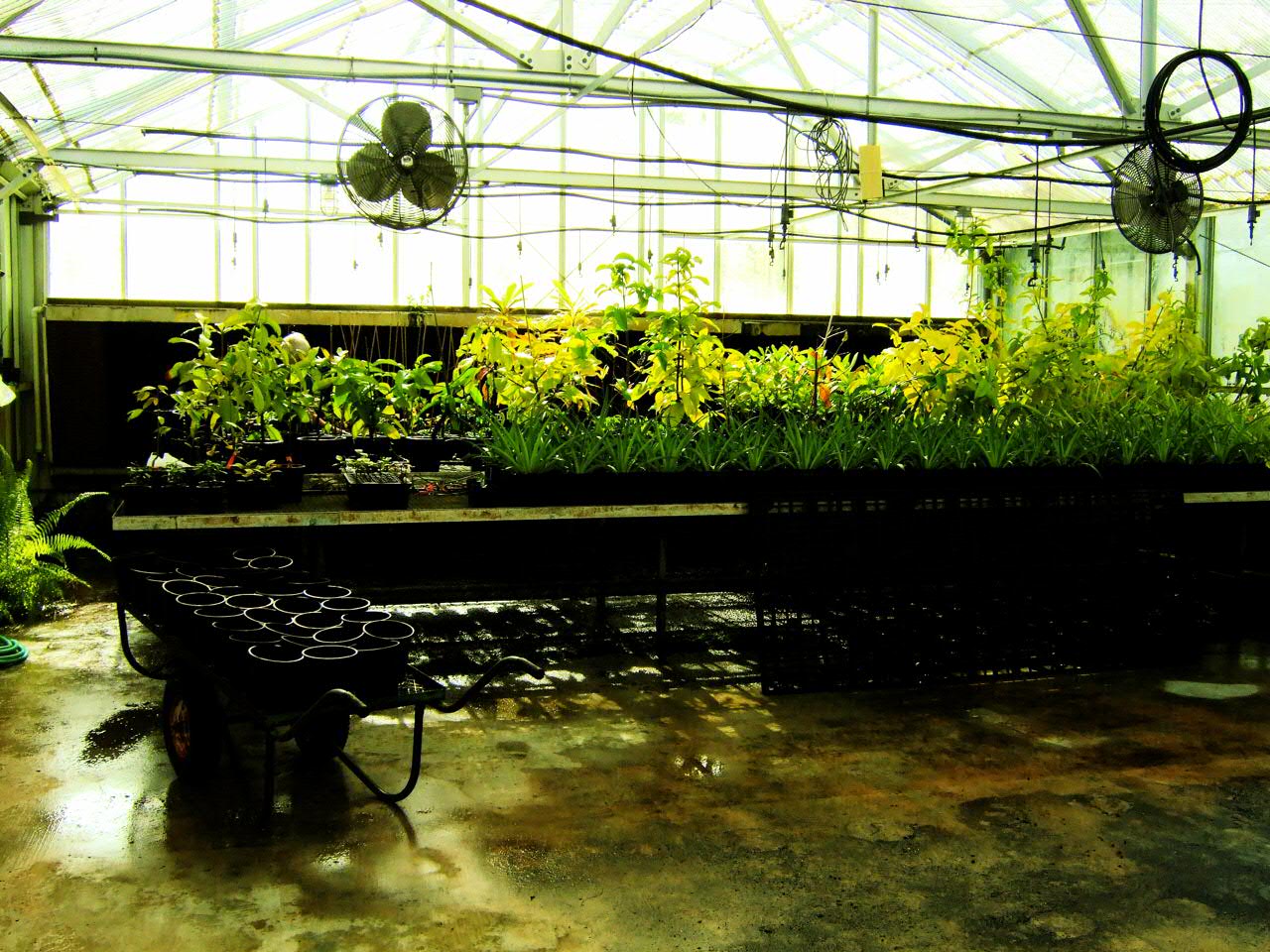 Our work station inside the nursery. That wall against the back is actually a HUGE filter-like metal screen that drips water on a timer.
Our work station inside the nursery. That wall against the back is actually a HUGE filter-like metal screen that drips water on a timer.
It was quite humid inside the nursery, but with open doors the air circulated (we're very close to Biscayne Bay here, so there's breezes). After seeing this nursery and working at the Whitman pavilion at the Fairchild grounds, I think I'm getting a better sense of what tropical really means (climate-wise) from a horticultural perspective.
The sapodilla is found in Florida as far north as Merritt Island, but mostly is found from Miami to Key West. . . . The flavor is like a cocktail combining pear, peach, brown sugar, cinnamon and a little brandy. Sapodilla fruits are soft, sweet and have a beautiful smell when ripe.We had to set up our repotted sapodilla on these long, metal tables that roll side-to-side. Although the nursery has a sprinkler system, we tried to attach a dripper to each plant. The drippers are small hoses lined up on the middle of each table.From the Tropical Fruit Collection (scroll down)
 Our work station inside the nursery. That wall against the back is actually a HUGE filter-like metal screen that drips water on a timer.
Our work station inside the nursery. That wall against the back is actually a HUGE filter-like metal screen that drips water on a timer.It was quite humid inside the nursery, but with open doors the air circulated (we're very close to Biscayne Bay here, so there's breezes). After seeing this nursery and working at the Whitman pavilion at the Fairchild grounds, I think I'm getting a better sense of what tropical really means (climate-wise) from a horticultural perspective.
August 22, 2008
The Secret Life of an Orchid
This is a cattleya phaleanopsis from my own collection. Orchids never cease to amaze the imagination!
And speaking of orchids, recently a social media acquaintance of mine happened to be trudging through the Everglades and spotted a rare ghost orchid! Check out his Flickr photoset of the adventure.
August 14, 2008
Reclamation Project
The Reclamation Project at the Miami Science Museum is a participatory eco-art project developed by Miami artist Xavier Cortada to help restore native habitats for plants and animals across our community.
The Reclamation Project is the beautiful brainchild of Xavier Cortada, a Miami-based artist devoted to environmental causes. Xavier is an dear old friend of mine; I've known him since my undergrad college days, when he was in law school at UM.
If you've driven in downtown Miami, you've seen some of Xavier's artwork painted on the columns in the underpasses. The strange-looking creatures are actually his interpretation of mangrove seedlings.
Last year, I volunteered with the Reclamation Project and it was a very rewarding experience. A group of adults and schoolchildren helped Xavier plant some mangrove seeds in a protected area of Key Biscayne's Crandon Park. Knowing that each mangrove seed has the potential to flourish and become natural habitat makes the task a very powerful gesture. Xavier told me that he had fond memories of walking around that area with his father when he was a child. His passion and real love for the environment is readily apparent even in simple conversation. I love that he has taken nature to an art form; reclaiming the environment gives everyone a chance to leave a mark on the canvas of the earth.
Helping restore the environment is Xavier's way of giving to the community. In a county where urban development boundaries are a joke, Xavier's project is all the more important.
If you've lived on Miami Beach, you know what I'm talking about. Actually, now that I'm living in South Miami, Miami Beach seems like a concrete jungle to me. It's so congested with high-rises, you hardly know you're on an island. Compared to South Miami and the Everglades, Miami Beach doesn't even feel tropical anymore! That's just incredible, isn't it? On those barrier islands that were sweeped clean of natural vegetation, there remains (as far as I know) only one mangrove area that wasn't replaced by a sea wall -- the border of Indian Creek and Pinetree Park.
On August 24th, Reclamation Project will be collecting mangrove seedlings at Bear Cut. And in September, we'll plant 1100 seedlings at Virginia Key. If you want to get to know the real Florida up close and personal, this is a great way to do it. Visit Reclamation Project to learn more. If you don't want to get down and dirty, you could also contribute by adopting a mangrove seedling for $25. This part of the project is in collaboration with Miami's Museum of Science. Xavier has also collaborated with the museum on the Native Flags project, which is an urban reforestation effort in South Florida.
Xavier has pursued other singular opportunities to do environmentally-conscious art work on an international scale. He has been to both the North and South pole! I joked with him that he was probably the first hot-blooded Cuban to set foot at Antarctica's McMurdo station and would probably contribute to global warming. All kidding, of course! Xavier created some "ice paintings" that I had a chance to see last year at a Wynwood exhibit. He "painted" with ancient ice -- it's really groovy stuff.
ADDITIONAL INFO
You may have seen mangrove seedlings on display at South Beach storefronts. I wrote an article about Xavier's project at Miami Beach 411 in '06 that explains it all.
You can also see mangrove habitats at Fairchild in the "wetlands" area of the garden. Expect to see some iguanas, too!
In the spirit of Nature Girl, I continued my passion for trekking in the muck yesterday at Matheson Hammock park. Below is another video I shot on my cellphone.
August 12, 2008
Jackfruit
Jackfruit growing right outside the fruit pavilion's entrance. Each fruit can weigh up to 80 pounds!
Volunteering - August 1
I didn't volunteer the past two Fridays because Jon-Mario was taking some time off. Then last week, I strained my shoulder at the gym, so I had to refrain from physical activity for a couple of days.
This past week though, we worked very hard at "spring cleaning" the fruit pavilion. Dr. Richard Campbell, Senior Curator of Tropical Fruit, was pruning many of the trees inside the pavilion and outside in the orchard.
Jon-Mario and I also dug soil away from the base of the tree trunks so that their roots could better absorb water. It was a very physically strenuous session, but all worth it, of course!
 Some of the trees may have been originally planted too deep. We exposed the surface area around the base of this Langsat tree so that water from the sprinklers can now readily reach its roots.
Some of the trees may have been originally planted too deep. We exposed the surface area around the base of this Langsat tree so that water from the sprinklers can now readily reach its roots.I had a chance to chat briefly with Noris Ledesma, Tropical Fruit Curator. She told me that they are selling fruit from Williams Grove on Sundays. Don't forget: admission is free on Sundays, August through September.
The Kampong
I recently wrote an article about The Kampong for Miami Beach 411. I had a chance to tour this historic bayside property with its director, David Lee. The Kampong is part of the National Tropical Botanical Garden and not associated with Fairchild Tropical Botanic Garden as an institution, but it is the former home of plant explorer David Fairchild (the garden's namesake).
In 1916, David Fairchild and his wife Marian settled on the property. As Chief of the Seed and Plant Introduction Section of the US Department of Agriculture, David Fairchild explored the world and introduced about 20,000 types of plants to this country, some of which he planted at The Kampong. Barbour Lathrop, a wealthy American philanthropist, sponsored many of Fairchild’s expeditions. “Fairchild helped establish avocado in California,” said David Lee, director of The Kampong. “His work broadened the American palette by introducing many kinds of fruit.”Read more about David Fairchild's former home at 411.
August 4, 2008
Bromeliad
Update: The bromeliad is called Vriesea regina.
I don't know the scientific name of this bromeliad, but I will find out. Its flower is clearly magnificent! It grows as tall as a small tree and is very fragrant.
Subscribe to:
Posts (Atom)

